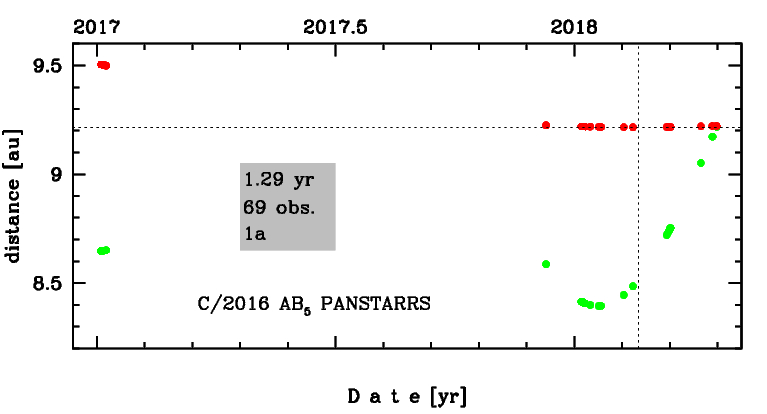C/2017 AB5 PANSTARRS
more info
Comet C/2017 AB5 was discovered on 3 January 2017 with Pan-STARRS 1 telescope (Haleakala), that is more than a year before its perihelion passage. This comet was rather rarely observed until 25 April 2019.
Comet had its closest approach to the Earth on 18 January 2018 (8.395 au), about a month before its perihelion passage.
The preferred solution given here is based on data spanning over 2.31 yr in a range of heliocentric distances: 9.50 au – 9.22 au (perihelion) – 9.53 au.
This Oort spike comet suffers small planetary perturbations during its passage through the planetary system and will have a bit more tight future orbit (see future barycentric orbit).
Comet had its closest approach to the Earth on 18 January 2018 (8.395 au), about a month before its perihelion passage.
The preferred solution given here is based on data spanning over 2.31 yr in a range of heliocentric distances: 9.50 au – 9.22 au (perihelion) – 9.53 au.
This Oort spike comet suffers small planetary perturbations during its passage through the planetary system and will have a bit more tight future orbit (see future barycentric orbit).
| solution description | ||
|---|---|---|
| number of observations | 69 | |
| data interval | 2017 01 03 – 2018 04 18 | |
| data type | perihelion within the observation arc (FULL) | |
| data arc selection | entire data set (STD) | |
| range of heliocentric distances | 9.5 au – 9.22 au (perihelion) – 9.22 au | |
| detectability of NG effects in the comet's motion | NG effects not determinable | |
| type of model of motion | GR - gravitational orbit | |
| data weighting | NO | |
| number of residuals | 130 | |
| RMS [arcseconds] | 0.33 | |
| orbit quality class | 1a | |
| orbital elements (heliocentric ecliptic J2000) | ||
|---|---|---|
| Epoch | 2018 02 11 | |
| perihelion date | 2018 02 18.14777758 | ± 0.17149717 |
| perihelion distance [au] | 9.21622360 | ± 0.00013333 |
| eccentricity | 0.99992136 | ± 0.00003676 |
| argument of perihelion [°] | 78.409754 | ± 0.008907 |
| ascending node [°] | 42.689610 | ± 0.000410 |
| inclination [°] | 32.430845 | ± 0.000087 |
| reciprocal semi-major axis [10-6 au-1] | 8.53 | ± 3.99 |
